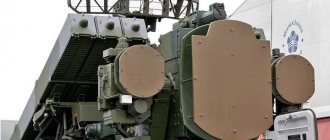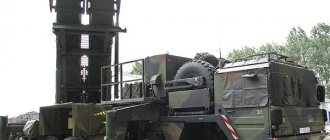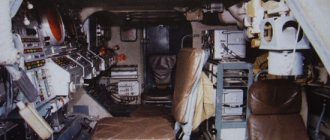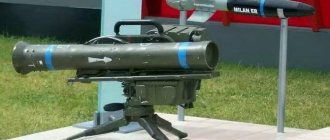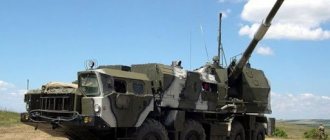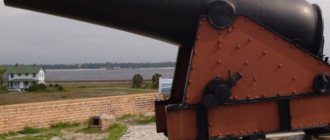In the seventies, NATO countries became the owners of several modernized high-speed anti-ship missiles, manufactured using modern technologies. Equipped with homing heads and capable of flying at low altitudes above the surface of the water, these installations posed a serious threat to enemy ships. To successfully counter NATO high-speed missiles, Soviet designers produced the Kortik anti-aircraft missile and artillery system.
Who designed the ZRAK?
Design work on the Kortik missile and artillery complex began in the late 1970s. The design was carried out at KBP in the city of Tula. Serial production of the Kortik complex was carried out by workers of the Tula Machine-Building Plant. The radar system was manufactured at the radio engineering enterprise in Serpukhov, and the combat equipment was manufactured at the F.V. Lukin Research Institute of Physical Problems. The anti-aircraft missile and artillery complex "Kortik" (GRAU 3M87), also known as the ZRAK "Kashtan" (export name), entered service in 1989.
Purpose
The plans of Soviet designers were to replace outdated anti-aircraft systems with the new Kortik anti-aircraft complex. To do this, it was necessary to eliminate the problems inherent in the old shipborne air defense systems. In order for the Dirk to successfully withstand NATO high-speed missiles, it must have:
- improved capabilities in the field of target detection and tracking, including high-speed;
- increased ammunition;
- accelerated recharge;
- increased probability of hitting the target.
Progress
During the design process, Soviet designers decided not to limit themselves to creating a purely artillery or purely anti-aircraft missile system. In their opinion, new weapons should have the best qualities of these two protective systems combined. Tula designers had already assembled a similar system, known as the Tunguska land air defense system. "Kortik" - an anti-aircraft missile and artillery complex - was designed taking into account existing developments from "Tunguska". When assembling the new ZRAK, the designers used ready-made components. Some of them were completely, without changes, transferred to Dirk. The missile system nevertheless contains most of the elements that had to be designed anew.
Knife dirk in Russia
The “fashion” for wearing daggers was brought to Russia by Peter 1, who himself constantly wore these weapons, considering them an important part of his uniform. It is known that the tsar was very scrupulous about his fleet (he was also its founder), so he ordered all officers to wear daggers. Over the years, the shape of the weapon and its size changed, but not critically, and the dirk always symbolized the dignity, power and honor of the Russian fleet.
Peter 1 went even further and compiled a list of those who, by order, must carry these weapons - these included officials who worked in the naval departments. Over time, a habit emerged and took root, which has survived to this day - not to go ashore without your cutlass.
After the death of Peter 1, the history of the dagger “suspended” its development. It ceased to be a symbol of the fleet and began to be used everywhere by soldiers of other troops, becoming an ordinary melee weapon.
The new history of the dirk in Russia began with the advent of Soviet power.
Watch the video about the USSR dagger:
Features of the structure of the new ZRAK
The Kortik anti-aircraft missile and artillery complex can be equipped with one or two command modules containing a radar station and a digital control system. For a small ship there is one combat module equipped with missiles and guns, and for a large destroyer or cruiser there are several, with a whole range of different anti-aircraft weapons. If necessary, combat modules (3С87) can be installed on any part of the deck. One module, without ammunition, weighs 9 thousand 500 kg, with ammunition - 12 thousand kg. For its installation, a special rotating platform has been developed, allowing for horizontal aiming of weapons. The upper part of the module is equipped with radar and optical-electronic stations responsible for targeting the target. The side surfaces of the platform became the location for cannons and missiles.
Grade
Joint processing of signals from optical-electronic and radar channels for target tracking and an anti-aircraft guided missile with automatic selection of the appropriate mode ensures high noise immunity. During tests that took place in the late 1980s, the Kortik air defense system was found to be ineffective due to its large dimensions and weight. Moreover, in practice, he simply did not have time to complete the shooting with machine guns of enemy anti-ship missiles that were not shot down by his own missiles. As a result, the heavy weight in most cases did not allow such installations to be placed instead of the AK-630M anti-aircraft artillery complex. On the Project 1293 cruisers, which were planned to be laid down in the early 90s, it was decided to abandon the air defense system in favor of operating the Kinzhal air defense system, as well as anti-aircraft guns. Then it was intended to eliminate the main drawback of the ZRAK in the modernized version of the M.
ZRAK is used on patrol ships of Project 11354M and 11540, the cruisers “Admiral Nakhimov”, “Peter the Great” and the BOD “Admiral Chabanenko”. Already from the second ship of Project 20380, the anti-aircraft missile artillery system was not installed as a result of the impossibility of its simultaneous deployment with the Redut air defense system (based on the S-350) with the possibility of using different types of long- and medium-range missiles. For defense against anti-ship missiles, 2 ZAK AK-630M are used.
But this does not mean that the ZRAK concept itself was abandoned - 2 Broadsword ZRAKs are installed on Project 22350 frigates.
Armament
ZRAK "Dirk" is equipped with:
- Anti-aircraft guided two-stage solid fuel missiles 9M311-1, having fragmentation rod warheads and non-contact target sensors.
- Two six-barreled AO-18K anti-aircraft guns of 30 mm caliber, capable of aimed shooting at a distance of 2-4 km.
- A command module that performs target detection, distribution and issuance of instructions to combat modules.
- One or six combat modules. They receive target designations coming from command modules, perform automatic target tracking and fire using both missiles and artillery weapons.
- A special system responsible for storing and reloading ship weapons. This system consists of containers in which combat modules are lifted and placed in the cellar.
In order to protect missiles from powder gases, there are special cylindrical casings on the cannon barrels. The ZRAK "Kortik" uses a screw-linkless feed of projectiles. The complex is fully automated.
Ship's ZRAK "Dirk"
In the seventies of the last century, several new types of anti-ship missiles entered service with NATO countries. The use of the latest technology made these munitions especially dangerous for enemy ships. A high-speed missile, equipped with an effective homing head and flying at an altitude of several meters above the water, posed a great danger to the ship, since intercepting it was a very difficult task. To protect ships from such threats, a new anti-aircraft weapon system was required, its characteristics superior to those available.
Combat module 3S87 ZRAK 3M87 “Dirk” (Kashtan - air defense gun/missile system (booklet). Rosoboronexport. 2000s)
In the late seventies, work on the “Dirk” theme began at the Tula Instrument Design Bureau. The project manager was A.G. Shipunov. As part of the scientific and design work, it was planned to create a new anti-aircraft complex intended for installation on ships and capable of combating all types of existing and future threats. To accomplish the tasks at hand, it was necessary to eliminate several problems inherent in old ship anti-aircraft systems. Thus, it was necessary to significantly improve the capabilities of the anti-aircraft complex in the field of detection and tracking of targets, including high-speed ones; increase the probability of hitting a target; as well as increase the amount of ammunition ready for use and speed up reloading.
As a result of analyzing the capabilities of modern and promising anti-ship missiles, it was decided to make not an artillery or anti-aircraft missile system, but a system that combines the best qualities of both of these means of defense. As a result, "Kortik" became a rocket and artillery weapon. By this time, Tula designers already had some experience in creating such systems, since not long before they had created the Tunguska ground anti-aircraft missile and artillery complex (ZRAK). It was decided to use some existing developments. In particular, some components of the Tunguska were transferred to the Dirk almost unchanged.
A pair of combat modules 3S87 ZRAK 3M87 “Dirk” on the TAKR “Admiral of the Fleet of the Soviet Union Kuznetsov” pr.11435, photo probably 2010 (https://china-defense.blogspot.com)
However, most of the elements of the ship's air defense system "Kortik" (GRAU index 3M87) were designed anew. Such novelty can be seen even in the structure of the complex: depending on the need, one ship can receive one or two Kortik air defense missile system command modules, equipped with a target detection radar and a digital control system, and up to six combat ones. Thus, a small ship or boat can carry only one combat module with missiles and guns, while a large destroyer or cruiser receives several sets of anti-aircraft weapons, which meets the needs of a particular class of ships.
The 3S87 combat module, with some restrictions, can be installed on almost any part of the ship’s deck, depending on the need. The total weight of the module is 9500 kg (12 thousand kg with ammunition). The main equipment of the combat module is mounted on a common rotating platform, which allows missile and artillery weapons to be aimed in a horizontal plane. At the top of the rotary module there are radar and optical-electronic stations designed to guide weapons to the target. Guns and missiles are placed on the side surfaces of the 3S87 combat module.
The artillery part of the Kortik complex includes two AO-18 automatic cannons of 30 mm caliber. Six-barreled guns are capable of firing at a rate of up to 4.5-5 thousand rounds per minute and conduct effective fire at ranges of up to 1500-2000 meters. The maximum sighting range is 4 kilometers. To avoid damage to the missiles by powder gases, the barrel blocks of both guns are covered with cylindrical casings. The ready-to-use ammunition capacity of each gun is 500 shells. It is interesting that, unlike previous artillery systems, the Kortika ammunition system uses a screw-type, linkless supply of shells to the guns. Ammunition is stored in two drums next to the guns, and not in the turret volume.
Shipborne anti-aircraft missile and artillery complex Kortik na on the TFR "Steregushchy" pr.20380
Above the guns in the combat module are missile launchers. On the sides of the upper part of the 3S87 module there are two swinging platforms on which blocks of transport and launch containers for guided missiles are mounted. The standard ready-to-use ammunition of the ZRAK "Kortik" missile unit is six or eight missiles. After these missiles are used up, new ones can be supplied from the cellar. To simplify production and operation, the 9M311 missile, with minimal changes, was borrowed from the Tunguska land-based anti-aircraft complex. According to some sources, for some time the missile for the Kortik was called 9M311K, but later the last letter disappeared as unnecessary. A two-stage rocket with solid propellant engines and a launch weight of about 43 kg (60 kg in a container) accelerates in flight to a speed of about 900-910 meters per second. The maximum range is 8000 meters. Damage height – up to 4000 m.
9M311 missiles are launched to the target using a radio command guidance system. The capabilities of radar and optical-electronic stations make it possible to simultaneously track up to six targets. Moreover, according to some data, one combat module can attack only one target at a time. The 9M311 radio-guided missile destroys a target using a fragmentation rod warhead, the first used on a guided munition for a ship's anti-aircraft system. When an explosive is detonated, rods 600 millimeters long and 4 to 9 mm in diameter are crushed into fragments. In addition, for additional target destruction, light, ready-made fragments are placed on top of the rods in the warhead. The greatest effectiveness of destruction is achieved when the warhead is detonated at a distance of 3-5 meters from the target.
The characteristics of the missile and artillery weapons of the Kortik complex allow it to destroy targets of various types located in a sector with a radius of up to 8 kilometers and a width of about 350 meters from the axis of the combat module. In the case of anti-ship missiles, the maximum effective firing range is reduced to 5 km. The capabilities of the 3S87 combat module allow for a kind of layered air defense. Thus, at ranges from 1.5 to 8 kilometers, the target is attacked using guided missiles. A target that breaks through the missile defense is attacked by two rapid-firing cannons. The applied architecture of the Kortik complex makes it possible to attack both aircraft and high-precision aircraft weapons, as well as anti-ship missiles, with high efficiency. The stated probability of hitting a target located in the range of the complex exceeds 95%.
When creating the new shipborne air defense missile system “Kortik”, it was assumed that in the future it would partially or completely replace old artillery systems of a similar purpose. Because of this, for example, the diameter of the shoulder strap of the 3S87 combat module corresponds to the same parameter of the AK-630 artillery complex. However, in practice, both systems are adjacent to each other and are used in parallel. The fact is that the Dirk complex was put into service only in 1989 and, due to subsequent difficult events in the life of the country, could not become the main anti-aircraft weapon of ships in the near zone. In addition, one of its characteristic features contributed to the wide distribution of this complex. The combat module has a height of 2250 mm above the deck, which imposes certain restrictions on the choice of its location.
However, a number of types of ships received new missile and artillery systems. The first carrier of the Kortik complex modules during their testing was the Project 1241.7 Molniya missile boat. Test firing and fine-tuning of all systems were carried out on it. Subsequently, serial "Dirks" were installed on ships of other projects. Thus, the heavy aircraft-carrying cruiser Admiral Kuznetsov of Project 1143.5 is equipped with eight combat modules of the Kortik air defense system. Two heavy nuclear-powered missile cruisers of Project 1144 (“Admiral Nakhimov” and “Peter the Great”) each carry six combat modules. The large anti-submarine ship "Admiral Chabanenko" of Project 1155.1 has four combat modules. Two or one module with missile and artillery weapons are installed on patrol ships of Project 11540, as well as frigates of Projects 1135.6 and 11661.
Back in the early nineties, a new designation ZRAK “Dirk” appeared in advertising materials. An option called “Chestnut” was offered for export. According to available data, the export version of the Kortik was almost no different from the basic version intended for ships of the Russian navy. In this configuration, the Kashtan air defense missile system attracted the attention of foreign buyers in the form of the Indian military. Project 1135.6 frigates built for India carry one combat and one command module of an anti-aircraft complex. From 2003 to 2013, the Indian Navy received ten Project 1135.6 frigates equipped with the Kashtan air defense system.
In 2008, the Project 20380 patrol ship Steregushchy, armed with the new Kortik-M air defense system, was accepted into the Russian Navy. The modernized version differs from the basic complex in some design elements and weapons. All applied changes ultimately had a beneficial effect on the characteristics and capabilities of the entire anti-aircraft system. For example, it was possible to achieve a noticeable lightening of the structure. The total mass of the combat module with ammunition does not exceed 10 tons.
The artillery part of the complex is made on the basis of AO-18KD automatic guns, which are a further development of the basic AO-18. The main difference between the updated guns is the initial velocity of the projectile. With the help of longer barrels, the Kortika-M cannons accelerate high-explosive fragmentation shells to a speed of 960 m/s, and armor-piercing sub-caliber shells to 1100 m/s. Thus, using the same projectiles and having similar characteristics of range and height of destruction, the AO-18KD anti-aircraft guns provide greater efficiency in hitting the target. The total ammunition load of artillery pieces has been increased to 3,000 shells.
In addition to new guns, the Kortik-M ZRAK also received new missiles. The 3M311-1 guided ammunition, while maintaining the dimensions and weight of its predecessor, is capable of hitting targets at a maximum range of up to 10 kilometers. It should also be noted that the radio-electronic part of the ship's anti-aircraft complex has been updated. Allegedly, the reaction time of “Kortika-M” is noticeably shorter than that of the ZRAK of the previous model. This indicator, according to various sources, ranges from 3-6 to 5-7 seconds. For comparison, the Dirk complex can attack a target only 6-8 seconds after it is detected.
In parallel with the Kortik-M complex, an export version called Kashtan-M was created. In the first half of the 2000s, it was offered to the Indian military for installation on the aircraft carrier Admiral Gorshkov (later this ship received a new name, Vikramaditya). After numerous negotiations, India abandoned these anti-aircraft systems. As a result, at the moment the updated Kortik-M is used only in the Russian Navy.
Based on materials from the sites: https://rbase.new-factoria.ru/ https://kbptula.ru/ https://redstar.ru/ https://militaryrussia.ru/blog/topic-16.html
Performance characteristics
- ZRAK "Dirk" is designed to hit targets in two zones:
By rockets:
1) 1 km 500 m – 8 km;
2) 5 km – 3 km 500 m.
Artillery:
1) 500 m – 4 km;
2) 5 m – 3 km.
- The rate of fire of the ZRAK is 10 thousand shots in one minute.
- Reaction time 8 sec.
- The accuracy of the radar guidance channel is within two to three meters.
- “Dirk” is characterized by a high probability of defeat: 94-99%.
Who uses the complex?
The carriers of the ZRAK “Dirk” were:
- Heavy nuclear missile cruisers "Peter the Great" and "Admiral Nakhimov".
- Heavy aircraft-carrying cruiser "Admiral Kuznetsov".
- Patrol ship "Steregushchy".
Also, the Kortik air defense missile system is used by the patrol ships Neustrashimy and Yaroslav the Mudry, as well as by the frigate Talvar.
Export version of the anti-aircraft complex
In the 90s, the Kashtan ZRAK appeared, which is practically no different from its basic version, the Dirk. The only difference is that the Kortik complex is used only by the Russian Navy, and the Kashtan air defense system is intended specifically for export. The buyers of this version of the anti-aircraft system were the Indian military. The Indian Navy uses Project 1135.6 frigates. This frigate comes with one combat and one command module. During 2003-2013, ten such vessels of Project 1135.6 were sold to India, with Kashtan air defense systems installed on them.
What is a dirk, what does it look like: description and dimensions
The term dagger refers to a type of bladed weapon with a short blade, which can have different types of sharpening and was originally used as a military weapon.
Despite the fact that the type of structure of the dirk is as close as possible to a regular knife, its end is sharp, and this allows you to deliver precise, deep piercing blows.
The dimensions of the daggers are small, for example, the naval officer's dagger has a total length of only 400 mm, of which 275 mm is “given” to the blade. The longest sample is the standard officer - 490 mm overall parameter, of which 345 mm falls directly on the blade.
We recommend reading the article about why you should not give knives as gifts. From it you will learn whether and when you can give knives, what type of knife to choose as a gift, and what to do if you give a knife. And here is more information about the signs of edged weapons.



